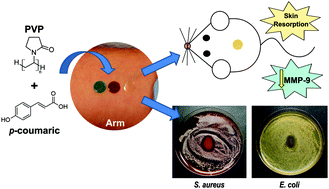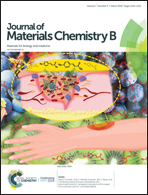Combining dietary phenolic antioxidants with polyvinylpyrrolidone: transparent biopolymer films based on p-coumaric acid for controlled release†
Abstract
Polyvinylpyrrolidone (PVP) has probably been one of the most utilized pharmaceutical polymers with applications ranging from a blood plasma substitute to nanoparticle drug delivery, since its synthesis in 1939. It is a highly biocompatible, non-toxic and transparent film forming polymer. Although high solubility of PVP in aqueous environment is advantageous, it still poses several problems for some applications in which sustained targeting and release are needed or hydrophobic drug inclusion and delivery systems are to be designed. In this study, we demonstrate that a common dietary phenolic antioxidant, p-coumaric acid (PCA), can be combined with PVP covering a wide range of molar ratios by solution blending in ethanol, forming new transparent biomaterial films with antiseptic and antioxidant properties. PCA not only acts as an effective natural plasticizer but also establishes H-bonds with PVP increasing its resistance to water dissolution. PCA could be released in a sustained manner up to a period of 3 days depending on the PVP/PCA molar ratio. Sustained drug delivery potential of the films was studied using methylene blue and carminic acid as model drugs, indicating that the release can be controlled. Antioxidant and remodeling properties of the films were evaluated in vitro by free radical cation scavenging assay and in vivo on a murine model, respectively. Furthermore, the material resorption of films was slower as PCA concentration increased, as observed from the in vivo full-thickness excision model. Finally, the antibacterial activity of the films against common pathogens such as Escherichia coli and Staphylococcus aureus and the effective reduction of inflammatory agents such as matrix metallopeptidases were demonstrated. All these properties suggest that these new transparent PVP/PCA films can find a plethora of applications in pharmaceutical sciences including skin and wound care.



 Please wait while we load your content...
Please wait while we load your content...